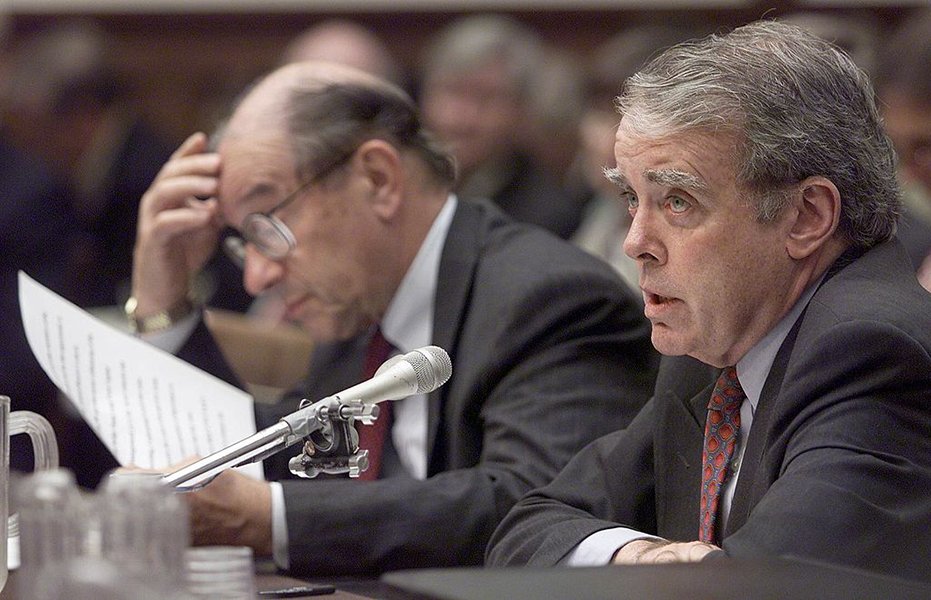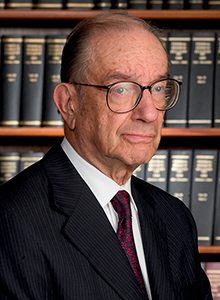Near Failure of Long-Term Capital Management
September 1998

On September 23, 1998, a group of fourteen banks and brokerage firms invested $3.6 billion in Long-Term Capital Management L.P. (LTCM) to prevent the firm's imminent collapse. The capital infusion forestalled a fire sale of LTCM assets into already turbulent markets and instead allowed for an orderly liquidation of the hedge fund's holdings. While the Federal Reserve brought the market participants together and oversaw the refinancing, it did not put its own funds at risk. Rather, creditors of LTCM—who had the most to lose from its bankruptcy—arranged and financed the rescue. The effort thereby addressed the near-term concerns of a possible fire sale of LTCM assets, while mitigating long-term moral hazard concerns that might have arisen from the use of public funds.
Led by a team of market experts including two Nobel laureates, LTCM was a hedge fund well known for using sophisticated mathematical models to make impressive profits. Founded by former Salomon Brothers Vice Chairman John Meriwether in February 1994, LTCM exploited temporary price differences between similar types of securities. Its "market-neutral" design meant it expected to make profits regardless of whether prices were heading up or down. LTCM generated above-normal returns of 20 percent in 1994, 43 percent in 1995, 41 percent in 1996, and 17 percent in 1997 (Siconolfi 1998).
By the nature of its strategy, LTCM earned low returns on each dollar invested. In order to earn high rates of return on its capital, the fund borrowed considerable money to leverage its positions. At the end of 1997, LTCM returned capital to its investors, without reducing the scale of its investments, thereby further increasing its already high leverage (Department of the Treasury, et al. 1999). As of the end of 1997, LTCM was holding about $30 in debt for every $1 of capital (Loomis 1998). Using its high leverage, LTCM sought profits in a broad range of markets—including those for government bonds, mortgage-backed securities, and equities—and entered into derivatives contracts extensively, including those for swaps, forwards, and options (Department of the Treasury, et al. 1999).
In 1998, the financial markets crisis that had started in Southeast Asia the previous year intensified. In August, Russia suddenly devalued its currency and stopped payments on its debt, spurring investors to seek safer and more liquid investments. LTCM had largely been betting on the spreads in its portfolios to converge, but in almost every case, they diverged (Lowenstein 2000). The fund lost 44 percent of its value in August alone. In late August, shortly after suffering huge losses on August 21, LTCM began seeking additional capital. The fund's need for capital became broadly known when LTCM disclosed its August losses in its September 2 letter to investors (Siconolfi 1998).
On September 18, LTCM officials contacted Federal Reserve Bank of New York President William McDonough about its financial problems.1 A team from the New York Fed visited LTCM two days later. While the Fed had been aware of LTCM's situation through its usual market monitoring activities, the dangerous scale and scope of LTCM's positions became apparent only upon closer inspection. The Fed came to be concerned that if LTCM's extensive list of counterparties tried to exit their positions at the same time, it would create a rapid and widespread sale of assets, a fire sale, which could potentially impair the economy.
On September 22, the New York Fed invited a core group of three firms to a meeting to discuss the LTCM situation. The core group, later expanded to a fourth firm, formed three working groups to consider possible solutions, one of which came up with the idea of a consortium approach. A broader group of thirteen firms was invited to the New York Fed that evening to discuss the approach. The firms disagreed over how much each firm should contribute to a rescue package and could not commit to such an effort on such short notice (Siconolfi 1998).
The talks on a combined rescue reconvened on the morning of September 23, but were soon halted by news that an investor group led by Warren Buffet had made an independent offer to buy out the firm's partners for $250 million and subsequently inject $3.75 billion capital into the fund (Loomis 1998). This appeared a clean solution to both the creditors and the Fed, and McDonough advised Meriwether that it was likely his best bet (Schlesinger and Schroeder 1998). By the 12:30 p.m. deadline, however, the offer was not accepted due to reported legal issues.
With no other solution in sight, the talks resumed with more haste inside the New York Fed. The consortium ultimately came to an agreement at about 6:00 p.m. on September 23. Together, fourteen firms put up $3.625 billion in capital in exchange for 90 percent of the fund's ownership (two firms included in the talks declined to participate). Under the arrangement, LTCM's partners were required to run the day-to-day operations of the company with no bonuses and limited salaries, and they had to report closely to an oversight committee made up of representatives from the consortium (Lowenstein 2000). Under this new leadership, LTCM sold most of its remaining positions and returned the last of the group's $3.6 billion investment by the end of 1999 (US General Accounting Office 2000). LTCM's partners and other investors suffered substantial losses when their claim was reduced to 10 percent, on top of the market-driven declines before the recapitalization.
The LTCM episode represents an instance where the Federal Reserve was able to facilitate the rescue of a failing financial institution without lending its own funds. Creditors of LTCM put up the funds, thereby mitigating the moral hazard concerns that might have arisen had public funds been used. At the same time, uncertainty about the fate of LTCM led to significant market disruptions including high volatility, low liquidity, and price discrepancies among similar securities. This suggests the need for an established mechanism to address the risks of fire sales arising from failing financial firms, rather than relying on the Fed to coordinate ad hoc private sector solutions at the last minute.
Endnotes
- 1 This discussion of the Fed's involvement is drawn from McDonough (1998). Also see US General Accounting Office (2000).
Bibliography
Department of the Treasury, Board of Governors of the Federal Reserve System, Securities and Exchange Commission, Commodity Futures Trading Commission, "Hedge Funds, Leverage, and the Lessons of Long-Term Capital Management," Report of the President's Working Group on Financial Markets, Washington, DC, April 1999.
Loomis, Carol J., "A House Built on Sand." Fortune 138, no. 8, October 26, 1998, 110-18.
Lowenstein, Roger. When Genius Failed: The Rise and Fall of Long-Term Capital Management. New York: Random House, 2000.
McDonough, William J. "Statement by William J. McDonough, President, Federal Reserve Bank of New York, before the Committee on Banking and Financial Services, U.S. House of Representatives," October 1, 1998. Available on FRASER.
Schlesinger, Jacob, and Michael Schroeder. "Greenspan defends Long-Term Capital Plan--More Threats Lurk in Market, Fed Chairman Testifies; Lawmakers Are Critical." Wall Street Journal, October 2, 1998.
Siconolfi, Michael, Anita Raghavan, and Mitchell Pacelle. "All Bets Are Off: How the Salesmanship and Brainpower Failed at Long-Term Capital." Wall Street Journal, November 16, 1998.
United States General Accounting Office. "Questions Concerning LTCM and Our Responses." GAO/GGD-00-67R. Washington, DC: United States General Accounting Office, February 23, 2000. Available online.
Written as of November 22, 2013. See disclaimer and update policy.



 X
X  facebook
facebook
 email
email